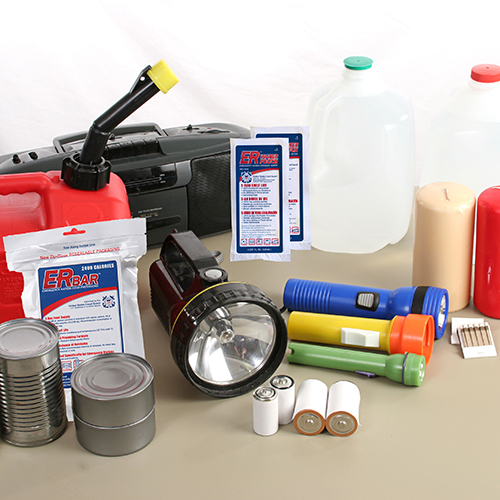Recent Posts
- Essential Earthquake Safety Information: How to Protect Yourself and Your Loved Ones
- What to Do In an Earthquake - The Complete Guide
- Georgia Resident Uses STOP THE BLEED® Training to Save Neighbor
- Emergency Preparedness for Older Adults
- Don't Be a Hot Dog: How to Keep Your Pets Safe This Summer
Maintaining Your Emergency Rations

An earthquake hits. A category 5 hurricane leaves a coastal city demolished. An ice storm takes down trees and power lines. After a disaster occurs, your primary focus should be to first, assess the situation and second, move to a safe location if necessary. Next comes securing food and potable water for you and your dependents. Obtaining an adequate supply of food and water in a crisis situation could be at best difficult and at worst impossible unless you already have a supply of food specifically set aside for an emergency. Most grocery stores operate on a “just in time” method of inventory control. On any given day, a typical grocery store will inventory a supply of stock to last approximately three days; however, increased demand can render this three-day stock insufficient. You only have to experience the rush on a grocery store when a snow storm is approaching to know that a three-day supply can disappear in hours.
The key to ensuring you and your loved ones have an adequate supply of life-saving food and water is to prepare BEFORE anything happens. FEMA and Red Cross recommend at the very least to have a 72-hour supply of food and water stored away for each family member. There are numerous types of emergency foods on the market which can make the task of building an emergency food supply complicated and time-consuming. To simplify this task, we recommend you begin building your food supply with high-calorie, vitamin enriched food bars such as the ER 2400 Calorie food bar. The ER Food Bar was formulated to contain 72-hours’ worth of calories and nutrition in one compact package that can be safely stored for up to 5 years. 3600 calorie food bars are available for those with higher calorie needs. These bars are a convenient addition to bug-out bags and home, office or classroom survival supplies.
You can supplement the ER Food Bar with additional non-perishable food items as needed such as canned goods and preserved meats, but be mindful of expiration dates. According to the USDA, canned goods do not necessarily spoil due to the commercial method of preserving food but they will lose nutritional value. Low-acid containing canned food such as fruits and tomatoes should be consumed within 24 months for optimal taste and quality. Low-acid canned goods such as meats and vegetables should be consumed within 2 – 5 years depending on the storage conditions. Although studies have been conducted that show canned goods could potentially last for much longer than these guidelines, it is a good practice to rotate your survival goods and throw any cans away that are dented or rusted. Consider adding Meals Ready to Eat (MREs) to your survival supply. Depending on the storage conditions, their shelf life can vary but MREs offer a diverse selection of food choices. According to studies conducted by the U.S. Army Natick Laboratory, shelf-life on MREs can range from 18 months to 84 months depending on the temperatures at which they are stored. Higher temperatures reduce the shelf-life while stable, lower temperatures extend shelf-lives. For longer term survival, freeze-dried goods are available with shelf-lives ranging from 10 – 25+ years. Be cognizant that many freeze-dried foods require water to rehydrate them. Take into consideration this possibility when planning your emergency water supply.
The most fundamental need for human survival is fresh water. Depending on the severity of the disaster, your home could be without potable water for several days or more. Stores may be stripped of bottled water leaving you completely dependent on your emergency supplies. An emergency water supply should contain 72-hours of water per person in the household. This equates to about 1 gallon per person. ER Water Pouches are a cost-effective and dependable solution for drinking water in an emergency. Each Tyvek pouch is hermetically sealed to maintain the water’s freshness for up to 5 years. Six pouches of ER water are all you need to keep a healthy person adequately hydrated for 72-hours. These pouches are easily stored indoors or outdoors in a bug-out bag or home survival kit and are a practical solution for drinking water. Keep in mind store-bought water bottles have a limited shelf life especially when stored in an area that experiences wide temperature fluctuations. On the website www.ready.gov/water, the U.S. Department of Homeland Security recommends bottled water be consumed by its “use by date” which can range from 6 months to a year. As with canned goods, these guidelines are subjective but exercise caution and periodically replenish your emergency water.
When faced with an emergency situation, drinking water is primary in importance, but you also need to consider a clean supply of water that can be used for cooking and cleaning. For that reason, FEMA and the Red Cross recommend 1 gallon/person of water be stored for each person. Consider keeping a 55-gallon drum of treated water outside your home or inside your garage or basement. The water barrel sold on QK.com is specifically designed to block harmful UV rays from penetrating the barrel thus ensuring the safe storage of water both indoors and outdoors. One bottle of Water Preserver Concentrate will treat 55-gallons of water for 5 years. After 5 years, simply empty the water out of the barrel, fill it up with fresh water and retreat it to last another 5 years.
Disasters can happen anywhere at any time. Don’t fall under the misconception that your area is immune to an emergency. You will never regret being prepared for a disaster, but you will regret not preparing for one. If your survival food and water are nearing their expiration dates, move it to your pantry and consume it. Donate the ER bars to your local food pantry or homeless shelter and freeze the ER pouches to use as ice packs. There is no need to waste money. Just remember to replenish your survival supply. Need advice on what you need to prepare your family? Call us at 800-277-3727.
Sources
